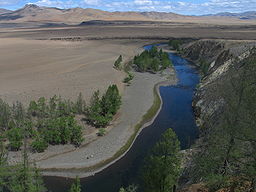- Orkhon River
-
Orkhon River (Орхон гол) Orkhon Gol River Country  Mongolia
MongoliaAimags Arkhangai, Bulgan, Selenge Major cities Kharkhorin, Bulgan Tributaries - left Tamir River - right Tuul River, Kharaa River Source - location Suvraga Khairkhan mountain in the Khangai Mountains, Arkhangai, Mongolia Mouth Selenge River Length 1,124 km (698 mi) Basin 132,835 km2 (51,288 sq mi) Discharge for Bulgan - average 66 m3/s (2,331 cu ft/s) - max 190.2 m3/s (6,717 cu ft/s) July - min 0.5 m3/s (18 cu ft/s) February The Orkhon River (Mongolian: Орхон гол, Orkhon gol) is a river in Mongolia. It rises in the Khangai Mountains of Arkhangai aimag and flows northwards for 1,124 km (698 mi) before joining the Selenge River, which flows north into Russia and Lake Baikal. The Orkhon is longer than the Selenge, making it the longest river in Mongolia. Major tributaries of the Orkhon river are the Tuul River and Tamir River.
There are two sets of ancient ruins along the river valley: Khar Balgas, the ancient capital of the Uyghur Kingdom and Karakorum, the ancient capital of the Mongol Empire. Pyotr Kuzmich Kozlov excavated several Hunnic Imperial tombs in the area of the river valley.
Very close to the Orkhon the Ulaan Tsutgalan river features a waterfall, ten meters wide and twenty meters high. The waterfall is a popular destination for tourists. Fish in the Orkhon river include pike, carp, perch, taimen and catfish.
UNESCO lists the Orkhon Valley as a World Heritage Site.
See also
- Khöshöö Tsaidam Monuments (World heritage site)
- List of rivers of Mongolia
References
H. Barthel, Mongolei-Land zwischen Taiga und Wüste, Gotha 1990, p.34f
"Сэлэнгэ мөрөн". www.medeelel.mn. http://www.medeelel.mn/index.php?page=land&sm=73&s=1345. Retrieved July 16, 2007.
External links
Coordinates: 47°33′24″N 102°49′53″E / 47.55667°N 102.83139°E[[be-x-old:Архон]
Categories:- Rivers of Mongolia
Wikimedia Foundation. 2010.



